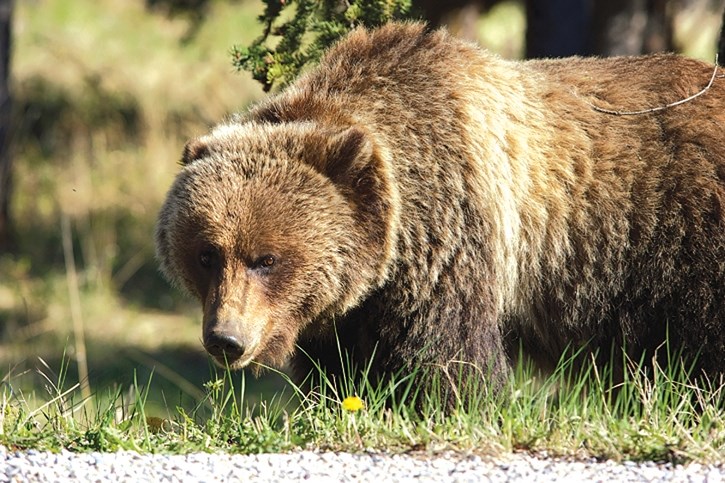BOW VALLEY - A highly anticipated report on human-wildlife coexistence contains 28 recommendations on reducing the probability and severity of wildlife encounters in the busy and highly developed Bow Valley.
BOW VALLEY - A highly anticipated report on human-wildlife coexistence contains 28 recommendations on reducing the probability and severity of wildlife encounters in the busy and highly developed Bow Valley.
Released on Thursday (May 31), many of the recommendations contained in the report have already been implemented to varying degrees.
Key recommendations include increasing cooperation across federal, provincial and municipal agencies, having areas and time for wildlife to be undisturbed and removal of attractants from areas considered no-go zones for wildlife, such as bears.
"This report is an example of the commitment by the jurisdictions of the Bow Valley to continue to strive towards finding a balance between human use and ensuring a healthy ecosystem for wildlife," states the 80-page report's conclusion.
The movements and management of a young female grizzly bear known as 148, and her subsequent death in 2017 after she was relocated hundreds of kilometres away from her home, shone a light on the challenges faced by wildlife and land managers in the Bow Valley.
These included enforcement, differing management tools and approaches, continued human activity in wildlife corridors, risks of injury, natural and unnatural foods in developed areas, public communication and a lack of public compliance.
Bear 148, a six-and-a-half-year-old bruin born in Banff National Park, spent 90 per cent of her time in the park, but began venturing outside the protected boundaries of the national park into the Canmore area in the summer to feast on buffalo berries.
Following several encounters with joggers, bikers, hikers and people with dogs in a heavily used area on the south side of Canmore, she was relocated to the northern end of Kootenay National Park - but it wasn't long before she was back in Canmore.
Local staff with three provincial government agencies made a consensus decision July 27 to close a large chunk of land on the south side of the valley near Quarry Lake and the power line to better manage 148 and reduce risk of someone getting hurt.
However, that decision was reversed when an order came down from higher-ranking provincial officials beyond the regional level to relocate bear 148. She was taken to Kakwa Wildland Provincial Park north of Jasper at the end of July.
The decision to relocate the bear, considered vital to the local, slowly reproducing population of about 60 grizzly bears, was a highly controversial one.
She was shot dead by a hunter in the then-legal hunt in B.C. in September.
The wildlife committee's technical working group recommends land mangers pursue opportunities in the medium term to remove, relocate and/or consolidate existing developments, such as trails, roads and buildings, within identified wildlife corridors, if they are impediments to wildlife habitat and connectivity.
"Where removals are not feasible, or as interim measures, try regulating human use, or restricting use to daylight hours to reduce nocturnal displacement of wildlife," the report states.
In addition, the group recommends increasing enforcement capacity over the short-term in developed areas to improve compliance regarding unsecured attractants.
"For example, enforce policies related to attractant bylaws, bear proof bins, dogs off leash and entering closed areas," the technical group wrote.
More work will be done on removing or securing natural and unnatural attractants, as well as removing hiding cover to discourage wildlife activity within developed areas.
"This includes removal of natural attractants like buffalo berry and elk calving, and unnatural attractants such as fruit trees or feral rabbits," states the report.
There are also recommendations centred on human use restrictions such as closures to be implemented annually where predictable patterns exist.
"Proactive management allows users to plan their recreational pursuits while allowing wildlife to learn predictable patterns of human use," according to the report.
"Reoccurring seasonal area closures provide habitat security to wildlife while reducing the need for reactionary closures in response to high rates of human-wildlife occurrences. Reactive area closures will remain necessary where unanticipated."
In addition, the technical committee recommends increasing legislation and enforcement capacity to respond to non-compliant behaviour.
"Increase capacity and allocation of resources for enforcement which may include non-traditional inter-agency enforcement opportunities within and across jurisdictions," the group recommends.
"In addition, the Government of Alberta currently lacks legislation which prohibits the feeding of dangerous wildlife."
Lastly, land managers are urged to implement proactive measures identified in the report in a bid to reduce the need for the removal of bears.
"The technical working group recommends continuing to research the effectiveness of translocations to ensure the best chance of success for translocated wildlife," it reads.
For a more in depth look at the recommendations, see next week's paper edition of the Outlook.
